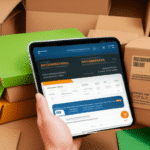Importance of Selecting the Right Logistics Strategy for Scaling
As your business experiences rapid growth, selecting the appropriate logistics strategy becomes crucial to maintain efficiency and customer satisfaction. A well-defined logistics strategy ensures the seamless movement of goods from production to delivery, optimizing costs and delivery times. According to a Forbes report, businesses that strategically manage their logistics see a 15% increase in operational efficiency.
Tailoring your logistics approach to your specific product types and customer locations can significantly enhance performance. For instance, perishable goods might require temperature-controlled transportation, while international shipping necessitates compliance with customs regulations. Understanding these nuances allows businesses to meet customer expectations consistently.
3PL vs. In-House Ownership: Advantages and Disadvantages
Advantages of Third-Party Logistics (3PL)
- Cost Efficiency: 3PL providers often have established networks that reduce shipping costs.
- Flexibility: Easily scale operations up or down based on demand fluctuations.
- Expertise: Access to industry knowledge and advanced logistics technologies.
Disadvantages of Third-Party Logistics
- Control Limitations: Less visibility and control over the supply chain can lead to delays and errors.
- Dependency: Relying heavily on a 3PL provider can pose risks if the provider faces issues.
Advantages of In-House Logistics Ownership
- Enhanced Control: Direct oversight of all logistics operations ensures better quality management.
- Customization: Ability to tailor logistics processes to specific business needs.
- Improved Customer Satisfaction: Faster and more reliable delivery can enhance the customer experience.
Disadvantages of In-House Logistics Ownership
- High Initial Investment: Significant capital is required for infrastructure, technology, and personnel.
- Resource Intensive: Managing logistics internally demands time and expertise that may divert focus from core business activities.
Transitioning from 3PL to Owning Your Logistics Operations
Key Considerations
Transitioning to in-house logistics requires careful planning. Assess the level of investment needed, including warehouses, transportation fleets, and technology systems. Additionally, evaluate the expertise required to manage these operations effectively.
Developing a Comprehensive Plan
Create a detailed roadmap outlining the transition steps, timeline, and milestones. Incorporate risk management strategies to address potential challenges such as service disruptions or initial cost overruns.
Building a Strong In-House Team
Recruit experienced logistics professionals and provide ongoing training to ensure your team can handle the complexities of logistics management. Establish clear communication channels to facilitate collaboration and continuous improvement.
Leveraging Technology in In-House Logistics Management
Transportation Management Systems (TMS)
Implementing a TMS can streamline transportation planning, execution, and optimization. According to a Supply Chain Digital article, businesses using TMS report up to a 20% reduction in transportation costs.
Warehouse Management Systems (WMS)
A robust WMS facilitates efficient inventory management, order fulfillment, and warehouse operations. Integrating WMS with other systems enhances data visibility and decision-making.
Automation and IoT
Adopting automation technologies and Internet of Things (IoT) devices can increase operational efficiency and provide real-time tracking of goods, further enhancing supply chain transparency.
Measuring Success and Overcoming Transition Challenges
Key Performance Metrics
- Customer Satisfaction: Track feedback and return rates to gauge service quality.
- Delivery Times: Monitor the time taken from order placement to delivery.
- Inventory Accuracy: Ensure inventory levels match actual stock to prevent overstocking or stockouts.
- Cost Efficiency: Analyze logistics-related expenses to identify cost-saving opportunities.
Overcoming Common Challenges
Common obstacles include resistance to change, high initial costs, and the complexity of managing new logistics systems. Address these by fostering a culture of adaptability, securing adequate funding, and providing comprehensive training for your team.
Engaging with logistics consultants or industry experts can also provide valuable insights and support during the transition process.
Case Studies and Future Trends in Logistics
Successful Transitions
Companies like Amazon have successfully transitioned to in-house logistics, enabling faster delivery and better control over their supply chain. Similarly, Target has enhanced its logistics capabilities to improve efficiency and customer satisfaction.
Emerging Trends and Innovations
The logistics industry is evolving with advancements in artificial intelligence, machine learning, and sustainable practices. Businesses are increasingly adopting green logistics solutions to reduce their environmental footprint, as highlighted by a World Economic Forum report.
Staying informed about these trends and integrating new technologies can provide a competitive edge and support long-term growth.
Conclusion
Shifting from third-party logistics to owning your logistics operations is a strategic move that can drive significant growth and efficiency for your business. By carefully selecting the right logistics strategy, leveraging advanced technologies, and building a capable in-house team, businesses can gain greater control over their supply chain, reduce costs, and enhance customer satisfaction. While the transition involves challenges and requires substantial investment, the long-term benefits can outweigh the initial hurdles, positioning your business for sustained success in a competitive market.






















